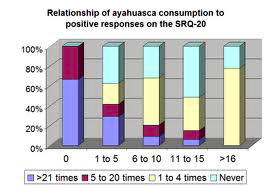We have talked before — here and here — about the Grob, McKenna, Callaway, et al. psychiatric study on the long-term effects of drinking ayahuasca in the ceremonies of the União do Vegetal church. I noted that the study had not clearly disentangled any bias that might have resulted from the fact that the ayahuasca drinkers — but not controls — had been preselected for their orderly churchgoing habits. Here is a study that may shed some light on that question.
 |
| Josep María Fericgla |
The twenty-question Self Report Questionnaire, or SRQ-20, is a screening tool for common mental disorders that investigates nonpsychotic symptoms — depression, anxiety, somatiform disorders — in the month prior to the interview. The questionnaire consists of four questions about physical symptoms and sixteen questions about emotional symptoms, all with yes-no answers — questions about such things as crying, tiredness, and inability to enjoy life. The test was validated in a Brazilian population, and thus is commonly used in South America to identify psychiatric symptoms in a primary care setting.
The higher the number of positive yes responses, the greater the likelihood of psychopathology. The validity study in Brazil reported that a score of more than eight positive responses is an adequate cut-off point to detect nonpsychotic mental disorders. The test was reported to have a sensitivity of 83 percent, a specificity of 80 percent, and both positive and negative predictive values of 82 percent, which makes the SRQ-20 a pretty good little test. Josep María Fericgla, director of the Institut de Prospectiva Antropológica in Barcelona, is an ethnopsychologist and cognitive anthropologist who has done fieldwork with Shuar shamans in Ecuador, and has written widely on shamanism and sacred plants, including a classic Shuar ethnography, Los jíbaros, cazadores de sueños. In his book Al trasluz de la ayahuasca: Antropología cognitiva, oniromancia y consciencias alternativas, he reports on his administration of the SRQ-20 to 113 Shuar, and analyzes the results according to the number of times each participant had drunk ayahuasca in the past.
The chart below should make the results clear. The stacked columns run from zero positive responses on the left to greater than sixteen positive responses on the right — that is, from left to right in order of increasing psychopathology.
 |
The chart clearly shows that Shuar who drank less ayahuasca had higher psychopathology scores on the SRQ-20, and those who drank more ayahuasca had lower psychopathology scores. Put another way, the chart shows Shuar who drink more ayahuasca stacked at the left-hand low-pathology end of the chart, and those who drink less ayahuasca stacked at the right-hand high-pathology end. Of those participants who gave zero positive responses, 72 percent had drunk ayahuasca more than 21 times.
The study also revealed that there appears to be a generally high rate of psychopathology among the Shuar: more than 60 percent of the participants gave eight or more positive responses on the SRQ-20. Fericgla attributes this unusual level to the accelerated process of deculturation that the Shuar were undergoing — the destruction of their traditional way of life, the plundering of their environment by multinational petroleum and lumber companies, territorial conflicts with colonists, the loss of their spiritual values. Even so, the distribution of the high scores is interesting. Of those who gave eight or more positive responses, 72 percent were women, and 35 percent were men. Part of the explanation may be that Shuar women bear the brunt of deculturation more than the men. Another part may be that Shuar men drink ayahuasca at twice the rate of women.
Now, again, what we have here is simply an apparent association between increasing ayahuasca consumption and lower scores on the SRQ-20. The study cannot tell us if there is a causal connection, or, if there is, in which direction it runs. It may be, for example, not that drinking ayahuasca causes better mental health, but rather that people with greater mental health — for any of a variety of reasons — drink more ayahuasca; or even that some third factor — family or social status, for example — is causally related to both.
But the bottom line of this study remains that — consistent with the results of the União do Vegetal study and, indeed, of the long-term study of peyote use we discussed here — there is little evidence that the long-term use of either sacred plant in its ceremonial setting causes any psychological harm, and appears to be associated with mental health benefits.

- Previous Post: Mark Your Calendar
- Next Post: Native American Film Festival
- More Articles Related to: Ayahuasca, Indigenous Culture, Research Studies, Sacred Plants



In reading this study it is wise to be well versed in the complimentary study of the MYTH of mental illness
Thank you for raising this very interesting issue.
As I understand it, Thomas Szasz is not saying that some people don’t have problems in living, or don’t feel sad all the time, or don’t feel so anxious that they have trouble relating to other people. He is saying that these are not medical conditions, and that medicalizing them has led to the creation of an oppressive social system he calls the Therapeutic State.
So, I am not troubled by taking out all the references to psychopathology in the post and instead talking about unusually high levels of sadness, crying, minor physical ailments, anxiety, or inability to enjoy life. The important fact, I think, is that higher levels of ayahuasca consumption are associated with fewer reports of these problems.